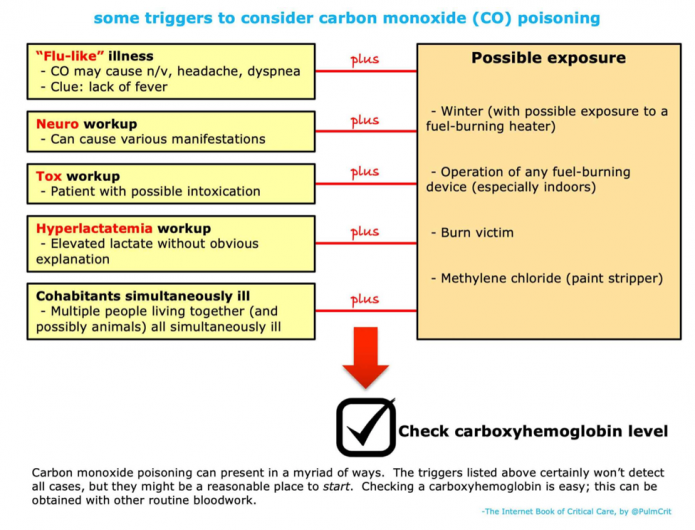Board Review: Pick your poison!
A 26-year-old male with a history of asthma presents to the ED at the peak of flu season in winter with nausea, myalgias, fatigue, and headache for the past 2 days. He reports that everybody living in the home is currently sick with the flu. He did not receive a flu vaccine this year. He is afebrile in triage with normal vital signs. On exam he appears mildly ill and sleepy. He is placed on continuous monitor and labs are pending. What should you do right now?
A. Give Oseltamivir
B. Consent patient for an emergent LP
C. Place on 100% via NRB
D. Begin broad spectrum antibiotics
C. Place on 100% O2 via NRB. This patient has vague flu-like symptoms - and so does his entire family living in the same house during the winter - with reassuring vital signs and a nonspecific exam. These are red flags for carbon monoxide poisoning that often occurs indoors due to faulty heaters, fireplaces, or generators. CO binds to hemoglobin with a higher affinity than oxygen, resulting in cellular hypoxia, impaired O2 delivery, and lactic acidosis. You should place your patient on 100% O2 via NRB immediately, which decreases the half-life of CO significantly. This patient has normal vital signs including a normal SpO2 because standard pulse oximetry cannot differentiate between carboxyhemoglobin and oxyhemoglobin. PaO2 will similarly be normal as it only measures dissolved O2 which is unaffected by CO. The carboxyhemoglobin level will be elevated and further clue you to the diagnosis (although keep in mind that smokers may have up to a 15% carboxyhemoglobin level at baseline). If the patient’s clinical status worsens, hyperbaric oxygen therapy may be considered.


Kesici, S., et al. (2014). Hyperbaric oxygen therapy for carbon monoxide poisoning. Journal of Health and Research. https://www.researchgate.net/publication/269950319_Hyperbaric_oxygen_therapy_for_carbon_monoxide_poisoning.
